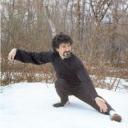Yahoo Answers is shutting down on May 4th, 2021 (Eastern Time) and beginning April 20th, 2021 (Eastern Time) the Yahoo Answers website will be in read-only mode. There will be no changes to other Yahoo properties or services, or your Yahoo account. You can find more information about the Yahoo Answers shutdown and how to download your data on this help page.
Trending News
Is it better to be relaxed or tense?
In the internal styles you stay relaxed and fluid and only tense up as you are striking. You also stay mentally calm and unaffected so your mind is clear. In the external styles you are more tense (though of course not rigid) throughout the sparring and use anger to give you energy. (These are generalities, of course). What is your approach in this regard?
16 Answers
- pugpaws2Lv 79 years agoFavorite Answer
Great question!!!
Hard styles are very misunderstood arts. your comments about hard styles is typical of the idea many have of hard styles. Tension is not supposed to be used until the last instant of movement. As soon as the strike transfers power the the striking hand should instantly relax. I teach it as if a firecracker went off at the instant of contact. The tension would be gone right after the explosion/transfer of power. We train on the Makiwara to learn this. After learning proper striking on the Maki, we add this. for instance we might punch the maki then allow the fist to totally relax as soon as the strike is delivered.
Anger...? Has, or should have, nothing to do with fighting. If you let anger control your actions, you will not do them correctly. Those that have not learned this yet are reckless fighters that win or lose as much by luck as by their skills. Those that have mastered both their physical skills and their mental control of their emotions are the best at what they do. Many try to fake being in control, but those in the know easily see through it.
...
Source(s): Martial arts training and research since 1967 Teaching martial arts since 1973 - 9 years ago
Hi Bob, do you know your generalities about external or hard styles are way off. Tension is only used at the last second of impact in both hard and soft styles. Staying relaxed and calm is a tenet of all martial systems. I don't know who gave you the wrong idea that hard styles use anger to give energy. Anger is always detrimental and will ruin your awareness and your focus. Its true that hard styles first use muscle for techniques thus appearing strained at times where soft styles appear to be more relaxed using momentum and fluid transitions. Both need a root and so both need rigidity to create a root though each style appears to approach rooting differently. You might find that some of the drills for balance are the same in hard and soft styles. There can be no hard without soft and there can be no soft without hard. Both are present in all martial systems although appearances can be deceiving.
In karate I have been taught to be calm, to move fast and relaxed. To hit hard as a rock and yet to be as flexible as a reed.
- SteppingLv 49 years ago
I have trained in both an internal and a external style for years and I can say without a doubt what you wrote here about external styles is incorrect (be a generality or not). External styles don't use anger to give you energy. Thats nonsense. Every style or method uses rigidity at times to strengthen or provide a base for movement/techniques. In both Internal and external styles you stay relaxed, focused, and only tense during the impact of a strike. A clear and calm mind is necessary in all martial arts and even in sports. Youre only showing prejudice towards other styles with this question.
- 9 years ago
I think you might even be being a little too general! In my style there is a very strong emphasis on what we call relaxed tense. You use the relaxed state for the speed then tense just before the strike impacts. I have also seen on the ultimate fighter tv show (season Gsp vs Koscheck), they bring a world class boxing coach in who explains the same thing.
In reference to your call on the mental side, clear is always best.
These are the approaches i use.
Source(s): karateka - How do you think about the answers? You can sign in to vote the answer.
- jwbulldogsLv 79 years ago
It doesn't matte if it is an internal or external style you are supposed to be relaxed. The only tense moment if there is one is only at the point of contact of the strike. We never teach students to be rigid or to use any emotions to give you energy.
Source(s): Martial Arts since 1982 Black Belt in Shorin Ryu Black Belt in Jujitsu Brown Belt in Judo - Jim RLv 79 years ago
Relaxation is key to accurate powerful techniques. I think trying to divide martial arts into "internal" or "external" styles is quite misleading. My style is considered by many as a "hard" style (shotokan). It is both a hard (external) and a "soft" (internal) style. One must trmain relaxed throughout the hard and soft applications if they are to work properly. I think your "generalities" are a little too general in this case.
Source(s): 40+ yrs shotokan - possumLv 79 years ago
Always relaxed. That doesn't mean cavalier. But with tense, you are more apt to react to things that ought not to be reacted to (eg, feints or strikes that will inevitably miss their mark).
Also, when you are tense, and you need to move, then more body has to be moved. When you are relaxed, then only the parts of the body that need to be moved are efficiently moved.
A punch, for instance, thrown by a tense person will move the whole body. Efficient? Not in the slightest.
Is there a need for tenseness? Yes, there are valid applications for it. But it is better to be relaxed and then need tense, rather than be tense and need to relax.
- KokoroLv 79 years ago
edited
i disagree with you about external styles. we dont use anger to give us energy, the mind still needs to be calm and relaxed, anger clouds the judgment and can leave your mind stuck, just like any strong emotion can. although i do agree with the ridged part at least in the beginning of training. we use more power for beginners rather then emphasizing softness which is done as we get more advanced.
as we get older we no longer have the same strength and need to rely more on being relaxed and using proper technique.
being relaxed gives the technique more power in the end.
even shotokan has its points in being relaxed when striking not all the kata techniques come from strength.
Source(s): 30yrs ma - Anonymous9 years ago
Considering Wang Xiangzhai was one of the greatest martial artists of the last 100 years, and he created his own internal martial art called Yiquan (aka dacheng chuan) (after winning over 1000 contests against martial artists all over China and only being bested by 2 people), I think it is indisputable that internal styles with a focus on relaxation and explosive energy as well as flow and precision are far superior to external styles which focus on cardio, strength and preset techniques.
But like one martial artist said, external styles are easier to get good at quickly. A person who takes up an external style will be able to defeat a person who takes up an internal style after they have both trained for 3 years. But after 30 years the internal style practitioner will be able to beat the external practitioner.
In other words, the potential for a higher level of mastery exists in internal arts. However, it is easier and quicker to get proficient at self defense with an external art even though the potential (generally speaking) doesn't exist for as high a level of mastery.
(the 2 people who beat Wang Xiangzhai were a LiuHeBaFa master (an internal art) and a Xin Yi Quan master (another internal art), although he was also matched by a White Crane practitioner (which I think is a bit of a hybrid art, it's more internal than other external styles are).
- ?Lv 69 years ago
I suppose I use a combination of both.
I trained to increase my pain threshold through methods kyokushin and Kajukenbo users may find familiar. After I was no longer as young and couldn't heal as well, I started to decide to focus more on the benefits of internal arts, which increase my timing and not so much my reflexes or damage tolerance.
In my arms and legs, I ascribe fully to the concept of yin and yang, as well as double load *but not necessarily double heavy*.
I selectively tense my core, dantien, and restrict the use of my muscles to only the ones that are required for twisting and spiral movements.
The benefits of rage appear only after a certain time period, thus was never reliable enough for me to use for self defense or ambush scenarios. I wanted an immediate solution, not one that happened after I got damaged. But after I get damaged, then external methods that give as much benefit as the fearsome reputation of PCP or cocaine/crack, will be useful for survival. Some of these drug addicts have been known to shrug off knife and pistol penetrations. I've never had to test my own abilities to that level.
Those that believe hard is synonymous with external and soft synonymous with internal, are wrong. It's more like one is on an X axis and the other is on a Y axis. External styles, such as Goju Ryu, utilize both hard and soft applications. Their forearm deflections are spiral in nature, thus soft, whereas ITF TKD's blocks are hard in nature.
One of the things martial artists, in general, should get a re-education on is the usage of terms and terminologies. Such as "resistance" and "relaxation". They use the words, but not in the way they were meant to be used. It is close, but not exact. The most common standard for people is to use these terms in a vague, ambiguous sense, as if their way of using it applies to everyone else. This has resulted in students that have either gotten the wrong idea of what relaxation and resistance is about, or it has resulted in students that stopped paying attention at the Mysticism.
An easy way to test this is to see if they can define relaxation or resistance. You'll see that everybody's definitions are close, but not exactly the same. The question of whether one or the other is better, does not compute. Because relaxation is not something that is good or evil, but a tool. A tool can be used to help or hinder depending on the user.







